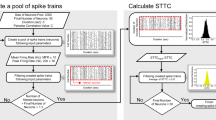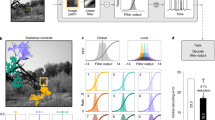Abstract
Sensory neurons code information about stimuli in their sequence of action potentials (spikes). Intuitively, the spikes should represent stimuli with high fidelity. However, generating and propagating spikes is a metabolically expensive process. It is therefore likely that neural codes have been selected to balance energy expenditure against encoding error. Our recently proposed optimal, energy-constrained neural coder (Jones et al. Frontiers in Computational Neuroscience, 9, 61 2015) postulates that neurons time spikes to minimize the trade-off between stimulus reconstruction error and expended energy by adjusting the spike threshold using a simple dynamic threshold. Here, we show that this proposed coding scheme is related to existing coding schemes, such as rate and temporal codes. We derive an instantaneous rate coder and show that the spike-rate depends on the signal and its derivative. In the limit of high spike rates the spike train maximizes fidelity given an energy constraint (average spike-rate), and the predicted interspike intervals are identical to those generated by our existing optimal coding neuron. The instantaneous rate coder is shown to closely match the spike-rates recorded from P-type primary afferents in weakly electric fish. In particular, the coder is a predictor of the peristimulus time histogram (PSTH). When tested against in vitro cortical pyramidal neuron recordings, the instantaneous spike-rate approximates DC step inputs, matching both the average spike-rate and the time-to-first-spike (a simple temporal code). Overall, the instantaneous rate coder relates optimal, energy-constrained encoding to the concepts of rate-coding and temporal-coding, suggesting a possible unifying principle of neural encoding of sensory signals.






Similar content being viewed by others
References
Adrian, ED (1926). The impulses produced by sensory nerve endings. The Journal of Physiology, 61(1), 49–72.
Aldworth, ZN, Dimitrov, AG, Cummins, GI, Gedeon, T, & Miller, JP (2011). Temporal encoding in a nervous system. PLoS Computational Biology, 7(5), e1002041.
Attwell, D, & Laughlin, SB (2001). An energy budget for signaling in the grey matter of the brain. Journal of Cerebral Blood Flow & Metabolism, 21(10), 1133–1145.
Baddeley, R, Abbott, LF, Booth, MC, Sengpiel, F, Freeman, T, Wakeman, EA, & Rolls, ET (1997). Responses of neurons in primary and inferior temporal visual cortices to natural scenes. Proceedings of the Royal Society of London Series B: Biological Sciences, 264(1389), 1775–1783.
Benda, J, & Herz, AV (2003). A universal model for spike-frequency adaptation. Neural computation, 15(11), 2523–2564.
Berger, T, & Levy, WB (2010). A mathematical theory of energy efficient neural computation and communication. IEEE Transactions on Information Theory, 56(2), 852–874.
Bialek, W, Rieke, F, de Ruyter van Steveninck, RR, & Warland, D (1991). Reading a neural code. Science, 252(5014), 1854– 1857.
Boerlin, M, Machens, C, Deneve, S, & Sporns, O (2013). Predictive coding of dynamical variables in balanced spiking networks. PLoS Computational Biology, 9(11), e1003258.
Brandman, R, & Nelson, ME (2002). A simple model of long-term spike train regularization. Neural Computation, 14(7), 1575–1597.
Brown, D, & Adams, P (1980). Muscarinic suppression of a novel voltage-sensitive k + ; current in a vertebrate neurone. Nature, 283(5748), 673–676.
Chacron, MJ, Longtin, A, & Maler, L (2001). Negative interspike interval correlations increase the neuronal capacity for encoding time-dependent stimuli. The Journal of Neuroscience, 21(14), 5328–5343.
Chacron, MJ, Pakdaman, K, & Longtin, A (2003). Interspike interval correlations, memory, adaptation, and refractoriness in a leaky integrate-and-fire model with threshold fatigue. Neural Computation, 15(2), 253–278.
Dayan, P, & Abbott, LF (2001). Theoretical neuroscience, Vol. 806. Cambridge: MIT Press.
Delmas, P, & Brown, DA (2005). Pathways modulating neural KCNQ/M (Kv7) potassium channels. Nature Reviews Neuroscience, 6(11), 850–862.
Eggermont, J, Johannesma, P, & Aertsen, A (1983). Reverse-correlation methods in auditory research. Quarterly Reviews of Biophysics, 16(03), 341–414.
Eggermont, JJ (1998). Is there a neural code? Neuroscience & Biobehavioral Reviews, 22(2), 355–370.
Farkhooi, F, Strube-Bloss, MF, & Nawrot, MP (2009). Serial correlation in neural spike trains: experimental evidence, stochastic modeling, and single neuron variability. Physical Review E, 79(2), 021905.
Gabbiani, F (1996). Coding of time-varying signals in spike trains of linear and half-wave rectifying neurons. Network: Computation in Neural Systems, 7(1), 61–85.
Gautrais, J, & Thorpe, S (1998). Rate coding versus temporal order coding: a theoretical approach. Biosystems, 48(1), 57–65.
Gerstner, W, & Naud, R (2009). How good are neuron models? Science, 326(5951), 379–380.
Goense, J, & Ratnam, R (2003). Continuous detection of weak sensory signals in afferent spike trains: the role of anti-correlated interspike intervals in detection performance. Journal of Comparative Physiology A, 189(10), 741–759.
Gollisch, T, & Meister, M (2008). Rapid neural coding in the retina with relative spike latencies. Science, 319(5866), 1108– 1111.
Hille, B, & et al. (2001). Ion channels of excitable membranes. Sinauer Sunderland, MA.
Hodgkin, AL, & Huxley, AF (1952). A quantitative description of membrane current and its application to conduction and excitation in nerve. The Journal of Physiology, 117(4), 500.
Johnson, EC, Jones, DL, & Ratnam, R (2015). Minimum squared-error, energy-constrained encoding by adaptive threshold models of neurons. In 2015 IEEE international symposium on information theory proceedings (ISIT), IEEE (pp. 1337–1341).
Jones, DL, Johnson, EC, & Ratnam, R (2015). A stimulus-dependent spike threshold is an optimal neural coder. Frontiers in Computational Neuroscience, 9, 61.
Kayser, C, Logothetis, NK, & Panzeri, S (2010). Millisecond encoding precision of auditory cortex neurons. Proceedings of the National Academy of Sciences, 107(39), 16,976–16,981.
Kiang, NYS, Wantanabe, T, Thomas, EC, & Clark, LF. (1965). Discharge patterns of single fibers in the cat’s auditory nerve. Cambridge: MIT Press.
Kistler, W, Gerstner, W, & Hemmen, J (1997). Reduction of the Hodgkin-Huxley equations to a single-variable threshold model. Neural Computation, 9(5), 1015–1045.
Kobayashi, R, Tsubo, Y, & Shinomoto, S (2009). Made-to-order spiking neuron model equipped with a multi-timescale adaptive threshold. Frontiers in Computational Neuroscience, 3, 9.
Laughlin, SB (2001). Energy as a constraint on the coding and processing of sensory information. Current Opinion in Neurobiology, 11(4), 475–480.
Laughlin, SB, De Ruyter van Steveninck, RR, & Anderson, JC (1998). The metabolic cost of neural information. Nature Neuroscience, 1(1), 36–41.
Levy, WB, & Baxter, RA (1996). Energy efficient neural codes. Neural Computation, 8(3), 531–543.
London, M, Roth, A, Beeren, L, Häusser, M, & Latham, PE (2010). Sensitivity to perturbations in vivo implies high noise and suggests rate coding in cortex. Nature, 466, 123–127.
Lüdtke, N, & Nelson, ME (2006). Short-term synaptic plasticity can enhance weak signal detectability in nonrenewal spike trains. Neural Computation, 18(12), 2879–2916.
MacKay, DM, & McCulloch, WS (1952). The limiting information capacity of a neuronal link. The Bulletin of Mathematical Biophysics, 14(2), 127–135.
Masuda, N, & Aihara, K (2003). Duality of rate coding and temporal coding in multilayered feedforward networks. Neural Computation, 15(1), 103–125.
Nabatiyan, A, Poulet, J, De Polavieja, G, & Hedwig, B (2003). Temporal pattern recognition based on instantaneous spike rate coding in a simple auditory system. Journal of Neurophysiology, 90(4), 2484–2493.
Nelson, M, Xu, Z, & Payne, J (1997). Characterization and modeling of p-type electrosensory afferent responses to amplitude modulations in a wave-type electric fish. Journal of Comparative Physiology A, 181(5), 532–544.
Nesse, WH, Maler, L, & Longtin, A (2010). Biophysical information representation in temporally correlated spike trains. Proceedings of the National Academy of Sciences, 107(51), 21,973–21,978.
Niven, JE, & Laughlin, SB (2008). Energy limitation as a selective pressure on the evolution of sensory systems. Journal of Experimental Biology, 211(11), 1792–1804.
Oswald, AMM, Doiron, B, & Maler, L (2007). Interval coding. I. Burst interspike intervals as indicators of stimulus intensity. Journal of Neurophysiology, 97(4), 2731–2743.
Panzeri, S, & Schultz, SR (2001). A unified approach to the study of temporal, correlational, and rate coding. Neural Computation, 13(6), 1311–1349.
Prescott, SA, & Sejnowski, TJ (2008). Spike-rate coding and spike-time coding are affected oppositely by different adaptation mechanisms. The Journal of Neuroscience, 28(50), 13,649–13,661.
Ratnam, R, & Nelson, ME (2000). Nonrenewal statistics of electrosensory afferent spike trains: implications for the detection of weak sensory signals. The Journal of Neuroscience, 20(17), 6672–6683.
Rudolph, M, & Destexhe, A (2003). Tuning neocortical pyramidal neurons between integrators and coincidence detectors. Journal of Computational Neuroscience, 14(3), 239– 251.
Sengupta, B, Stemmler, M, Laughlin, SB, & Niven, JE (2010). Action potential energy efficiency varies among neuron types in vertebrates and invertebrates. PLoS Computational Biology, 6(7), e1000840.
Strong, SP, Koberle, R, De Ruyter van Steveninck, RR, & Bialek, W (1998). Entropy and information in neural spike trains. Physical Review Letters, 80(1), 197.
Van Rullen, R, & Thorpe, SJ (2001). Rate coding versus temporal order coding: what the retinal ganglion cells tell the visual cortex. Neural Computation, 13(6), 1255–1283.
Yager, D, & Hopkins, C (1993). Directional characteristics of tuberous electroreceptors in the weakly electric fish, hypopomus (gymnotiformes). Journal of Comparative Physiology A, 173(4), 401–414.
Acknowledgments
This research was supported by National Science Foundation grants EFRI-BSBA-0938007 and IGERT 0903622, research funds from the College of Engineering, UIUC, Coordinated Science Laboratory, UIUC and the Advanced Digital Sciences Center, Illinois at Singapore. Electric fish data were collected in the laboratory of Mark E. Nelson, UIUC, through the National Institute of Health grant R01MH49242 and National Science Foundation grant IBN-0078206. We gratefully acknowledge the availability of rat cortical pyramidal neuron data in the public domain through the International Neuroinformatics Coordinating Facility.
Author information
Authors and Affiliations
Corresponding author
Ethics declarations
All applicable international, national, and/or institutional guidelines for the care and use of animals were followed.
Conflict of interests
The authors declare that they have no conflict of interest.
Additional information
Action Editor: Mark Goldman
Rights and permissions
About this article
Cite this article
Johnson, E.C., Jones, D.L. & Ratnam, R. A minimum-error, energy-constrained neural code is an instantaneous-rate code. J Comput Neurosci 40, 193–206 (2016). https://doi.org/10.1007/s10827-016-0592-x
Received:
Revised:
Accepted:
Published:
Issue Date:
DOI: https://doi.org/10.1007/s10827-016-0592-x




